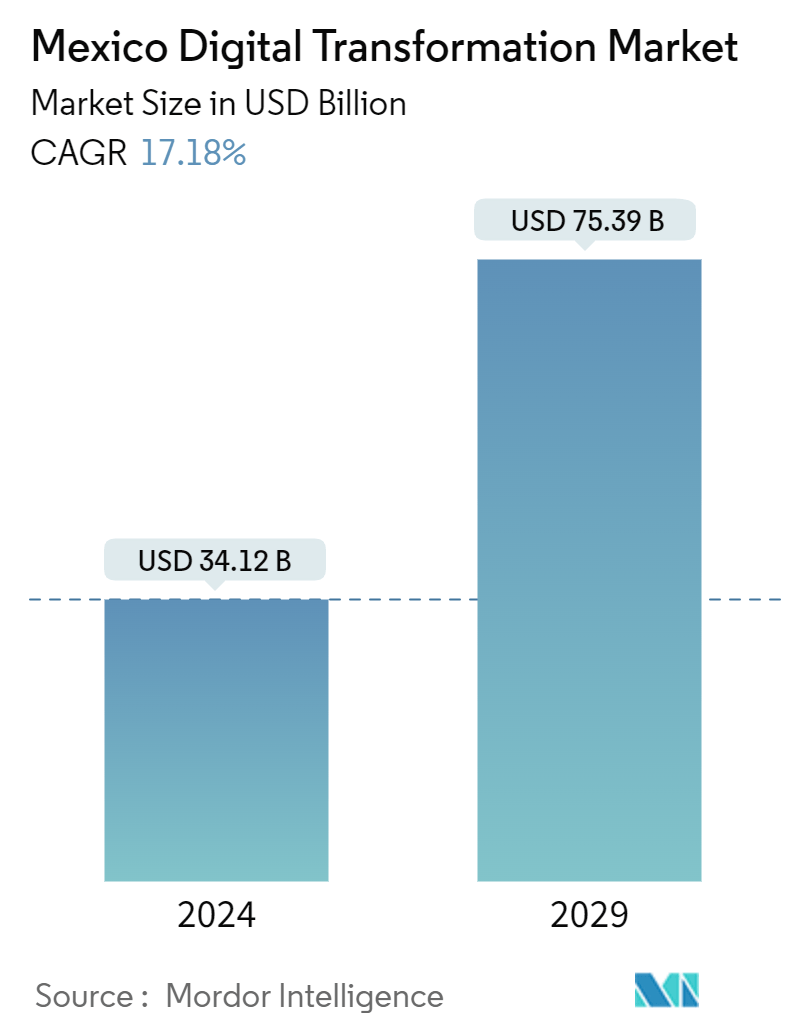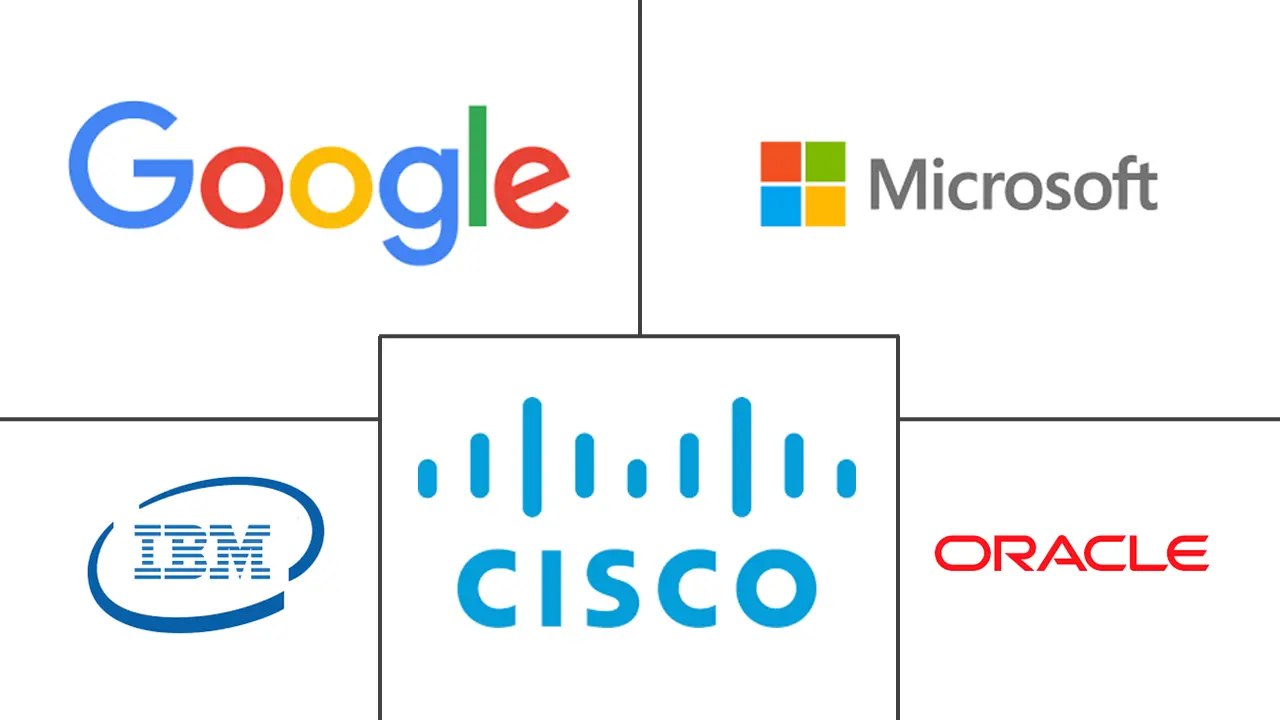Market Size of Mexico Digital Transformation Industry

| Study Period | 2019 - 2029 |
| Base Year For Estimation | 2023 |
| Market Size (2024) | USD 34.12 Billion |
| Market Size (2029) | USD 75.39 Billion |
| CAGR (2024 - 2029) | 17.18 % |
| Market Concentration | Medium |
Major Players
*Disclaimer: Major Players sorted in no particular order |
Mexico Digital Transformation Market Analysis
The Mexico Digital Transformation Market size is estimated at USD 34.12 billion in 2024, and is expected to reach USD 75.39 billion by 2029, growing at a CAGR of 17.18% during the forecast period (2024-2029).
- Mexico has implemented several digital transformation policies to modernize its government and promote the development of digital technologies. These policies include a whole-of-government approach, sound governance frameworks, and a national digital strategy. Additionally, Mexico has a digital economic policy agenda, which promotes policies and interventions to foster digital development. The country's leading development plan, the 2019-24 national development plan, also emphasizes the importance of national strategies and international cooperation for digital transformation. The Mexican government has established the Digital Transformation Center Mexico and has partnered with institutions like Google Cloud to accelerate its digital transformation measures.
- Further, Mexican society's reliance on information and communications technology (ICTs) and online government services has surged. The financial sector and the broader economy rely heavily on digital platforms. Yet, this interconnectivity also exposes the nation to risks, underscoring the critical need for a robust national security strategy. Mexico's National Cybersecurity Strategy, charting a course to 2030, is designed to equip the nation for the challenges of an increasingly digital landscape. Its overarching goal is to position Mexico as a resilient player in cyberspace, offering a broad, enduring framework for future endeavors.
- Moreover, The mouse revolutionized computer inputs, transitioning from the keyboard's linear to a two-dimensional realm. Building on this, gesture-based computing marks a leap, introducing three-dimensional inputs that immerse users in the computing experience. These interfaces foster a more intuitive learning approach, often resembling play, and hold significant promise, especially when paired with extended reality (XR). Within the market, advancements have given rise to the 'Kai gesture controller'—a wearable device that tracks hand movements, enabling users to control games and apps through gestures. Furthermore, it seamlessly pairs with devices via Bluetooth.
- Further, Mexico has been increasing its adoption of cloud computing in recent years, with the government at all levels playing an essential role. In particular, several initiatives are underway to improve the use of cloud services in the public sector. For example, the Mexican government has been working closely with cloud service providers like Oracle to strengthen the government services that they offer to the public. Customers in Mexico will have access to a wide range of network partners through the Oracle Cloud Querétaro region, allowing for a private and direct connection via OCI FastConnect.
- On the contrary, Artificial Intelligence (AI) is a pivotal opportunity within the life sciences industry, promising transformative potential. In the upcoming years, AI is set to be a focal point for investments, drawing a diverse range of organizations eager to harness its capabilities. As the applications of AI multiply, early investor interest is on the rise. Yet, despite its allure, investing in AI at the nascent stage can be challenging, potentially stunting a company's growth. Launching robust AI products demands substantial financial backing, and monetizing these ventures takes a lot of work. Moreover, developing such products often necessitates specialized teams in machine learning, adding to the financial outlay.
Mexico Digital Transformation Industry Segmentation
Digital transformation involves leveraging digital technologies to overhaul traditional business processes and adapt them to changing market and customer demands. This revolutionizes business management, operations, and customer value delivery.
The Mexico digital transformation market is segmented by type and by end-user industry. By type the market is segmented into analytics, artificial intelligence and machine learning, extended reality (XR), Iot, industrial robotics, blockchain, additive manufacturing/3D printing, cybersecurity, cloud and edge computing, and other. By end user industry the market is segmented into manufacturing, oil, gas and utilities, retail &e-commerce, transportation and logistics, healthcare, BFSI, Telecom and IT, government and public sector, others. The Market Sizes and Forecasts are Provided in Terms of Value (USD) for all the Above Segments.
| By Type | ||||||
| ||||||
| ||||||
| ||||||
| ||||||
| ||||||
| ||||||
| ||||||
| ||||||
|
| By End-User Industry | |
| Manufacturing | |
| Oil, Gas and Utilities | |
| Retail & e-commerce | |
| Transportation and Logistics | |
| Healthcare | |
| BFSI | |
| Telecom and IT | |
| Government and Public Sector | |
| Others |
Mexico Digital Transformation Market Size Summary
The Mexico Digital Transformation Market is experiencing significant growth, driven by the government's proactive policies and strategic partnerships aimed at modernizing digital infrastructure and promoting technological advancements. The country's national digital strategy, supported by initiatives like the Digital Transformation Center Mexico and collaborations with global tech giants such as Google Cloud, underscores the commitment to fostering a robust digital economy. This transformation is further propelled by the increasing reliance on information and communications technology (ICT) across various sectors, including finance, which is heavily dependent on digital platforms. The government's focus on cybersecurity, through its National Cybersecurity Strategy, aims to mitigate risks associated with this digital interconnectivity, ensuring a secure and resilient digital landscape.
The market is characterized by the rapid adoption of cloud computing and advanced technologies such as artificial intelligence (AI) and the Internet of Things (IoT), which are reshaping business operations and consumer interactions. The expansion of cloud services, exemplified by Oracle's strategic collaborations and Microsoft's establishment of a data center in Queretaro, highlights the growing demand for scalable and efficient digital solutions. Additionally, the banking sector's investment in digital transformation is enhancing operational efficiency and customer experience, with AI playing a pivotal role in fraud prevention and risk management. As the market continues to evolve, the convergence of these technologies is expected to drive further growth, offering businesses in Mexico a competitive edge in the global digital economy.
Mexico Digital Transformation Market Size - Table of Contents
-
1. MARKET DYNAMICS
-
1.1 Market Drivers
-
1.1.1 Increase in the adoption of big data analytics and other technologies across Businesses
-
1.1.2 The rapid proliferation of mobile devices and apps
-
-
1.2 Market Restraints
-
1.2.1 Data Privacy and Security Concerns
-
-
-
2. MARKET SEGMENTATION
-
2.1 By Type
-
2.1.1 Analytics, Artificial Intelligence and Machine Learning
-
2.1.1.1 Current Market Scenario and Market Projections for the Forecast Period
-
2.1.1.2 Key Growth Influencers (Drivers, Challenges, and Opportunities)
-
2.1.1.3 Use Case Analysis
-
2.1.1.4 Market Outlook
-
-
2.1.2 Extended Reality (XR)
-
2.1.2.1 Current Market Scenario and Market Projections for the Forecast Period
-
2.1.2.2 Key Growth Influencers (Drivers, Challenges, and Opportunities)
-
2.1.2.3 Use Case Analysis
-
2.1.2.4 Market Outlook
-
-
2.1.3 IoT
-
2.1.3.1 Current Market Scenario and Market Projections for the Forecast Period
-
2.1.3.2 Key Growth Influencers (Drivers, Challenges, and Opportunities)
-
2.1.3.3 Use Case Analysis
-
2.1.3.4 Market Outlook
-
-
2.1.4 Industrial Robotics
-
2.1.4.1 Current Market Scenario and Market Projections for the Forecast Period
-
2.1.4.2 Key Growth Influencers (Drivers, Challenges, and Opportunities)
-
2.1.4.3 Use Case Analysis
-
2.1.4.4 Market Outlook
-
-
2.1.5 Blockchain
-
2.1.5.1 Current Market Scenario and Market Projections for the Forecast Period
-
2.1.5.2 Key Growth Influencers (Drivers, Challenges, and Opportunities)
-
2.1.5.3 Use Case Analysis
-
2.1.5.4 Market Outlook
-
-
2.1.6 Additive Manufacturing/3D Printing
-
2.1.6.1 Current Market Scenario and Market Projections for the Forecast Period
-
2.1.6.2 Key Growth Influencers (Drivers, Challenges, and Opportunities)
-
2.1.6.3 Use Case Analysis
-
2.1.6.4 Market Outlook
-
-
2.1.7 Cyber security
-
2.1.7.1 Current Market Scenario and Market Projections for the Forecast Period
-
2.1.7.2 Key Growth Influencers (Drivers, Challenges, and Opportunities)
-
2.1.7.3 Use Case Analysis
-
2.1.7.4 Market Outlook
-
-
2.1.8 Cloud and Edge Computing
-
2.1.8.1 Current Market Scenario and Market Projections for the Forecast Period
-
2.1.8.2 Key Growth Influencers (Drivers, Challenges, and Opportunities)
-
2.1.8.3 Use Case Analysis
-
2.1.8.4 Market Outlook
-
-
2.1.9 Others
-
2.1.9.1 Current Market Scenario and Market Projections for the Forecast Period
-
2.1.9.2 Key Growth Influencers (Drivers, Challenges, and Opportunities)
-
2.1.9.3 Use Case Analysis
-
2.1.9.4 Market Outlook
-
-
-
2.2 By End-User Industry
-
2.2.1 Manufacturing
-
2.2.2 Oil, Gas and Utilities
-
2.2.3 Retail & e-commerce
-
2.2.4 Transportation and Logistics
-
2.2.5 Healthcare
-
2.2.6 BFSI
-
2.2.7 Telecom and IT
-
2.2.8 Government and Public Sector
-
2.2.9 Others
-
-
Mexico Digital Transformation Market Size FAQs
How big is the Mexico Digital Transformation Market?
The Mexico Digital Transformation Market size is expected to reach USD 34.12 billion in 2024 and grow at a CAGR of 17.18% to reach USD 75.39 billion by 2029.
What is the current Mexico Digital Transformation Market size?
In 2024, the Mexico Digital Transformation Market size is expected to reach USD 34.12 billion.

